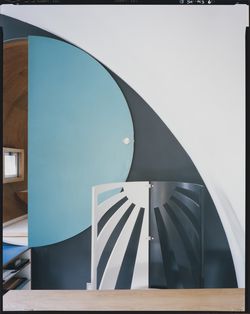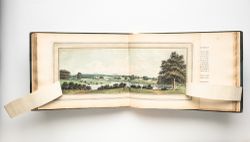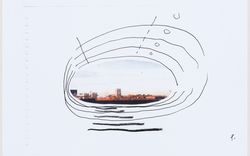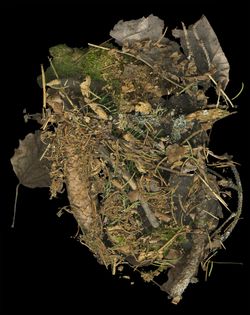archives
Niveau de description archivistique:
Collection
Collection Kiran Mukerji
CD038
Résumé:
The Kiran Mukerji collection contains Kiran Mukerji’s research material on building and design technologies for affordable housing, which consists mostly of publications, and a few textual records the Institut für Tropenbau (Institute for Tropical Building).
1972-2013
Collection Kiran Mukerji
Actions:
CD038
Résumé:
The Kiran Mukerji collection contains Kiran Mukerji’s research material on building and design technologies for affordable housing, which consists mostly of publications, and a few textual records the Institut für Tropenbau (Institute for Tropical Building).
archives
Niveau de description archivistique:
Collection
1972-2013
archives
Niveau de description archivistique:
Fonds
Fonds Peter Eisenman
AP143
Résumé:
The Peter Eisenman fonds documents Eisenman's professional activities as an architect, teacher, and author from the 1950s to 2008. More than 200 projects are represented through conceptual and design development drawings, models, photographs, textual records, and computer-aided drawings. Also well represented in the fonds are materials related to Eisenman's exhibitions, publications, and writings.
1925-2008, predominant 1951-2008
Fonds Peter Eisenman
Actions:
AP143
Résumé:
The Peter Eisenman fonds documents Eisenman's professional activities as an architect, teacher, and author from the 1950s to 2008. More than 200 projects are represented through conceptual and design development drawings, models, photographs, textual records, and computer-aided drawings. Also well represented in the fonds are materials related to Eisenman's exhibitions, publications, and writings.
archives
Niveau de description archivistique:
Fonds
1925-2008, predominant 1951-2008
archives
Niveau de description archivistique:
Fonds
Fonds Cedric Price
AP144
Résumé:
The Cedric Price fonds documents the personal activities and professional practice of architect Cedric Price, and includes his student work and architectural and urban planning projects. The fonds also contains records that document Cedric Price's teaching, publication, and exhibition activities. The archive comprises over 200 projects, from Price's student work in the 1950s at the University of Cambridge and the Architectural Association to projects he undertook as late as 2000. Key projects that are represented include New Aviary (1960-1966), Fun Palace (1961-1974), Potteries Thinkbelt (1963-1967), Inter-Action Centre (1971-1979), Generator (1976-1980), and Magnet (1995-1996).
1903-2006, predominant 1953-2000
Fonds Cedric Price
Actions:
AP144
Résumé:
The Cedric Price fonds documents the personal activities and professional practice of architect Cedric Price, and includes his student work and architectural and urban planning projects. The fonds also contains records that document Cedric Price's teaching, publication, and exhibition activities. The archive comprises over 200 projects, from Price's student work in the 1950s at the University of Cambridge and the Architectural Association to projects he undertook as late as 2000. Key projects that are represented include New Aviary (1960-1966), Fun Palace (1961-1974), Potteries Thinkbelt (1963-1967), Inter-Action Centre (1971-1979), Generator (1976-1980), and Magnet (1995-1996).
archives
Niveau de description archivistique:
Fonds
1903-2006, predominant 1953-2000
Figure ayant profondément marqué l’architecture d’après-guerre au Japon, Kazuo Shinohara s’est surtout fait connaître pour ses maisons individuelles. Or il reste peu étudié de nos jours, particulièrement à l’extérieur du Japon. Il a joint certaines formes traditionnelles et l’exploration de principes modernistes au moment des technologies de pointe et de l’information(...)
21 septembre 2017, 18h30
David B. Stewart, quel sens avait l’histoire pour Kazuo Shinohara?
Actions:
Description:
Figure ayant profondément marqué l’architecture d’après-guerre au Japon, Kazuo Shinohara s’est surtout fait connaître pour ses maisons individuelles. Or il reste peu étudié de nos jours, particulièrement à l’extérieur du Japon. Il a joint certaines formes traditionnelles et l’exploration de principes modernistes au moment des technologies de pointe et de l’information(...)
Série(s)
AP119.S1
Description:
The series contains drawings for Peter Yeadon's architectural narrative for the Prix de Rome entitled "Karl: An Architerctural Narrative." In total eleven sets of digital prints were made, each set contains eighteen sheets. Canadian Centre for Architecture received the third of these eleven sets, which is included in this series. The narrative depicts the experience of a Canadian emigrant becoming a Roman citizen. The drawings represent the following titles: City; Fabric House; Columbarium; Horizon House; House City; Depth House; Colosseum for Vanishing Curiosities; City Gate; Teatro de Tevere; Neptune House; Bath; and Bricolage House. Each drawing is signed by the architect. Also included, are four sketchbooks for 'Karl: An Architerctural Narrative', two print proofs for Bricolage House, and project documentation. The documentation explains each of the titles in the narrative, Yeadon's curriculum vitae, and leaflets for the exhibition "Karl: an architectural narrative" held at the Art Gallery of Windsor, Ontario from August 2001 to January 2002.
1998-2002
Karl: An Architectural Narrative (2000-2002)
Actions:
AP119.S1
Description:
The series contains drawings for Peter Yeadon's architectural narrative for the Prix de Rome entitled "Karl: An Architerctural Narrative." In total eleven sets of digital prints were made, each set contains eighteen sheets. Canadian Centre for Architecture received the third of these eleven sets, which is included in this series. The narrative depicts the experience of a Canadian emigrant becoming a Roman citizen. The drawings represent the following titles: City; Fabric House; Columbarium; Horizon House; House City; Depth House; Colosseum for Vanishing Curiosities; City Gate; Teatro de Tevere; Neptune House; Bath; and Bricolage House. Each drawing is signed by the architect. Also included, are four sketchbooks for 'Karl: An Architerctural Narrative', two print proofs for Bricolage House, and project documentation. The documentation explains each of the titles in the narrative, Yeadon's curriculum vitae, and leaflets for the exhibition "Karl: an architectural narrative" held at the Art Gallery of Windsor, Ontario from August 2001 to January 2002.
Series
1998-2002
archives
Niveau de description archivistique:
Fonds
AP170
Résumé:
The Mark Goulthorpe HypoSurface project records, 1990-2014, document the design development, technical implementation, exhibition, and marketing of various iterations of the HypoSurface wall. The wall has a “skin” divided up into pixel-like metallic facets manipulated by a network of actuating pistons in order to create images, texts and patterns in dynamic relief. Sensors allow people near the wall to influence its movement. The records include approximately 62,700 digital files, 3 folders of textual documents, and 44 prototype pieces, and a working HypoSurface wall module.
1990 - 2014
Documents d’archives de Mark Goulthorpe pour le projet Hyposurface
Actions:
AP170
Résumé:
The Mark Goulthorpe HypoSurface project records, 1990-2014, document the design development, technical implementation, exhibition, and marketing of various iterations of the HypoSurface wall. The wall has a “skin” divided up into pixel-like metallic facets manipulated by a network of actuating pistons in order to create images, texts and patterns in dynamic relief. Sensors allow people near the wall to influence its movement. The records include approximately 62,700 digital files, 3 folders of textual documents, and 44 prototype pieces, and a working HypoSurface wall module.
archives
Niveau de description archivistique:
Fonds
1990 - 2014
Des paysages à lire
Des paysages à lire est une petite sélection de livres de la collection du CCA qui réfléchissent sur le concept de paysage en constante évolution. Les livres exposés rassemblent diverses lectures du paysage et mettent en lumière des techniques et des formats dédition singuliers, en gardant à lesprit les lacunes intrinsèques à lhistoire de lédition qui sont présentes dans(...)
14 mars 2024 au 2 mars 2025
Des paysages à lire
Actions:
Description:
Des paysages à lire est une petite sélection de livres de la collection du CCA qui réfléchissent sur le concept de paysage en constante évolution. Les livres exposés rassemblent diverses lectures du paysage et mettent en lumière des techniques et des formats dédition singuliers, en gardant à lesprit les lacunes intrinsèques à lhistoire de lédition qui sont présentes dans(...)
articles
Un poumon pour Midtown Manhattan
Le projet de Cedric Price pour le concours CCA pour la conception des villes, 1999
Actions:
À travers une conversation modérée par Louise Désy, Conservateur, Photographies, du CCA, Lorraine Gilbert présente son oeuvre: La documentation des paysages dans lesquels j’ai vécu et travaillé, a engendré une œuvre questionnant notre place dans la nature et dans les environnements bâtis. Le caractère en apparence objectif avec lequel j’ai dépeint ces espaces naturels(...)
Salles principales Mot(s)-clé(s):
Le côté sombre d’une coupe à blanc, Canada, Le temps presse, causerie
4 février 2017, 15h
Le côté sombre d’une coupe à blanc
Actions:
Description:
À travers une conversation modérée par Louise Désy, Conservateur, Photographies, du CCA, Lorraine Gilbert présente son oeuvre: La documentation des paysages dans lesquels j’ai vécu et travaillé, a engendré une œuvre questionnant notre place dans la nature et dans les environnements bâtis. Le caractère en apparence objectif avec lequel j’ai dépeint ces espaces naturels(...)
Salles principales Mot(s)-clé(s):
Le côté sombre d’une coupe à blanc, Canada, Le temps presse, causerie
archives
Niveau de description archivistique:
Fonds
Fonds Van Ginkel Associates
AP027
Résumé:
The Van Ginkel Associates fonds is comprised of documents concerning van Ginkel Associates, van Ginkel Associates Ltd., Ecos Ltd., van Ginkel Partners, Ginkelvan Ltd, van Ginkel Associates Ltd. (1977), the styles under which H.P. van Ginkel and Blanche Lemco van Ginkel practiced as a multidisciplinary planning, management and architecture firm. Much of the van Ginkels' work was done in the Montréal area and nation-wide. The fonds contains approximately 1 985 drawings (1 420 originals plus 565 reproductions), 41 boards, 3 photographs, 2 collages, 2 typescripts, 1 model, 1 sketchbook and approximately 12.23 meters of textual documents. The documents were primarily produced between 1955 and 1980.
1944-1992
Fonds Van Ginkel Associates
Actions:
AP027
Résumé:
The Van Ginkel Associates fonds is comprised of documents concerning van Ginkel Associates, van Ginkel Associates Ltd., Ecos Ltd., van Ginkel Partners, Ginkelvan Ltd, van Ginkel Associates Ltd. (1977), the styles under which H.P. van Ginkel and Blanche Lemco van Ginkel practiced as a multidisciplinary planning, management and architecture firm. Much of the van Ginkels' work was done in the Montréal area and nation-wide. The fonds contains approximately 1 985 drawings (1 420 originals plus 565 reproductions), 41 boards, 3 photographs, 2 collages, 2 typescripts, 1 model, 1 sketchbook and approximately 12.23 meters of textual documents. The documents were primarily produced between 1955 and 1980.
archives
Niveau de description archivistique:
Fonds
1944-1992



